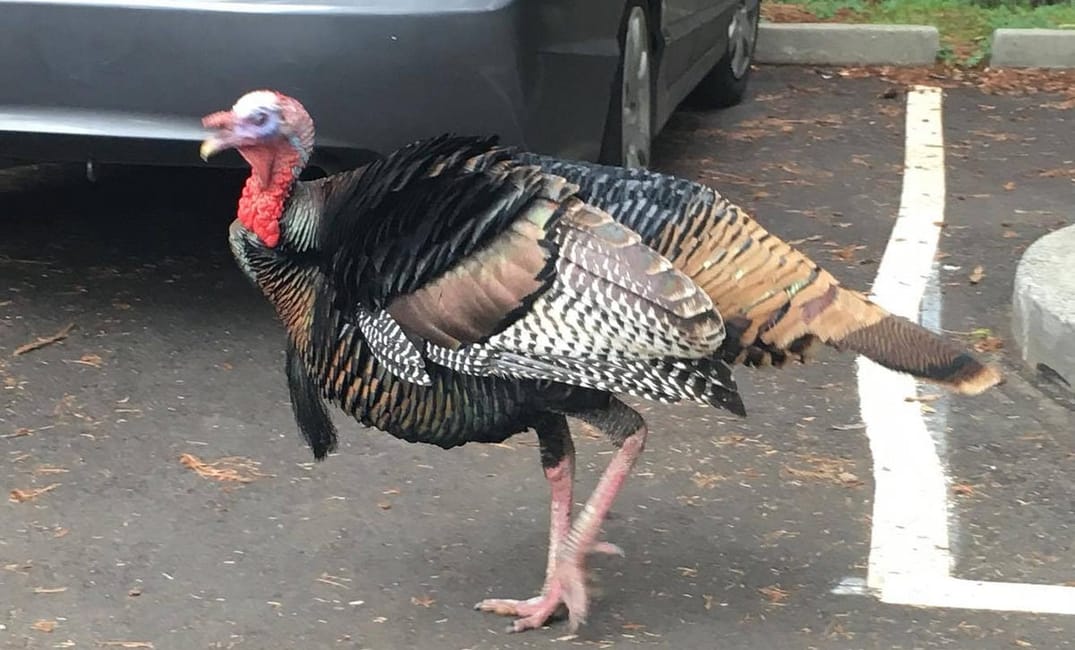Berkeley and Santa Cruz have been particularly hard-hit by the wild-turkey invasion.
He stalks a UC Santa Cruz parking lot during the daylight hours, threatening those who come too close to his turf. His adoring fans have endowed him (and his offspring) with a Facebook fan page. The students even gave him a name — Hank Hatebeak. And he has a bad habit of attacking car tires while they’re in motion:
But here’s the thing about Hank Hatebeak and the rest of the wild turkeys around here: they’re newcomers — at least, in this geologic epoch — to the Bay Area. When I was an undergrad at UCSC 10 years ago, I never once saw a turkey. Friends and professors with whom I spoke all said the same thing. And my father, who grew up in the heavily forested woodland behind Stanford, never once saw one during his youth.
Now wild turkeys are so common (and brazen) that they’re chasing people daily in Santa Cruz and Berkeley. Indeed, Berkeleyside has been documenting the myriad sightings (and attacks) in Berkeley since 2012.
“Originally, these turkeys were brought for hunting at private hunting clubs and on state-managed lands … it’s been sort of a continued population growth from that time, from the 1950s to the 1980s, when these releases were happening.”
Still, it seems a bit weird that a big urban area would be such a great environment for these wild animals. So what exactly is it that’s bringing wild turkeys to the urban parts of the Bay Area — especially towns like Berkeley and Santa Cruz?
Apparently, it’s been a long journey here for our feathered frenemies. Alan Krakauer, a UC Davis biology professor who specializes in the behavioral ecology of birds, explained that turkeys were brought back to California in the mid-20th century. “Originally, these turkeys were brought for hunting at private hunting clubs and on state-managed lands,” said Dr. Krakauer. “It’s been sort of a continued population growth from that time, from the 1950s to the 1980s, when these releases were happening.”
The wild turkeys’ range once extended across most of the United States, and the birds were a common sight in New England around the time of the Revolutionary War. Founding-father Benjamin Franklin famously defended the bird’s “respectability” as a symbol — though he did not, as the legend goes, propose outright that we use the turkey (rather than the bald eagle) as the symbol of the country.
Wild turkeys were almost eliminated from the United States between the late 1800s and early 1900s, said Krakauer. “Now that we have more regulations on when and where you can hunt, that’s made a big difference in the recovery of these populations … you don’t see people in the middle of these urban areas hunting them.” Hence, without any predators, once they invade an urban area, they can be hard to get rid of.
Plus, wild turkeys love all the open space in the Bay Area: Tilden Park, the vast wilderness of the Santa Cruz mountains and all our other open-space preserves, nestled between populous towns, make for good living for wild turkeys. But problems arise when brazen turkeys like Hank Hatebeak venture to the edge of the wilderness and hang out around people (and cars).
Native Bay Area residents might wonder whether the turkeys are technically transplants. “It’s a contentious issue: whether to call turkeys in California ‘native’ or ‘introduced,’” said Dr. Krakauer. Turkeys have certainly been in California before. Wild turkeys are one of the most common fossils found in the La Brea tar pits and were present in Southern California in the Pleistocene. But “most of the introduced ones here were brought from the Texas or Oklahoma area,” said Krakauer. “The landscape here is similar, so the turkeys adapted easily to California.”
Still, with Thanksgiving around the corner, you might be thinking what I’m thinking: there sure are a lot of these birds in parts of the Bay Area, and many of them are quite big. And plump. Could a hungry, carnivorous citizen, er, kill and eat one?
“You’d need to check with the city or county,” said Krakauer, laughing. “I don’t think you can just go into Tilden and shoot.”
The long answer to this question is “It’s complicated.” You need a permit, which can take a while, and the hunting season is open only for a month this year — from November 12 to December 11. (The SF Chronicle put together a guide last year as to where and how to hunt turkey.) In other words, in lieu of a rogue coyote or mountain lion busting in, Hank Hatebeak is untouchable, the king of UC Santa Cruz — and our cars will just have to take his abuse.

Do you have your own terrifying turkey-attack saga? Share your story (or picture) in the comments section below.







